FREE Standard Shipping On All Orders $100 or More!*
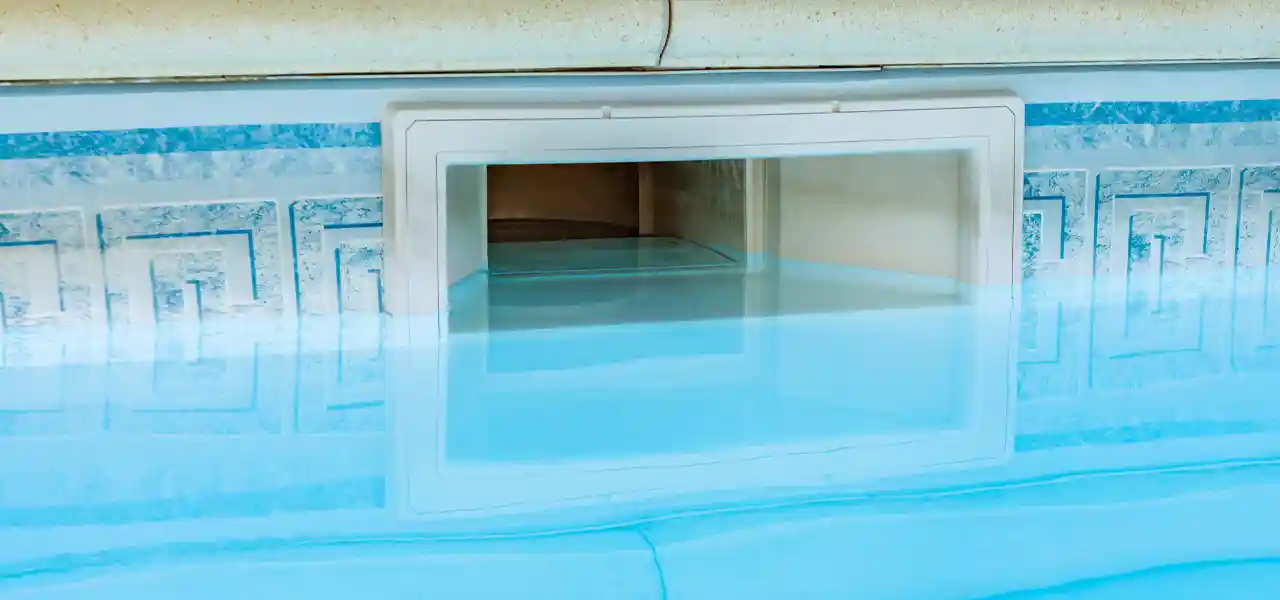
Inground Pool Skimmer Plumbing Diagrams
When you look down into your pool skimmer, you may see two holes, one at 12 o'clock and another opposite hole, at 6 o'clock. This gives the pool builder some flexibility in how to connect the plumbing pipes underneath the skimmer.
They can run a pipe from the main drain into the front hole of the skimmer, and then the back hole is the suction pipe that goes to the pool pump.This reduces costs, compared to running a separate main drain pipe, all the way back to the pump.
Here's some common inground pool skimmer plumbing configurations that you may encounter. I have shown these skimmers connected with schedule 40 pvc, although on some pools you may encounter flex pipe, or black poly pipe being used, which is sub-standard to PVC.
Combination Inground Pool Skimmers
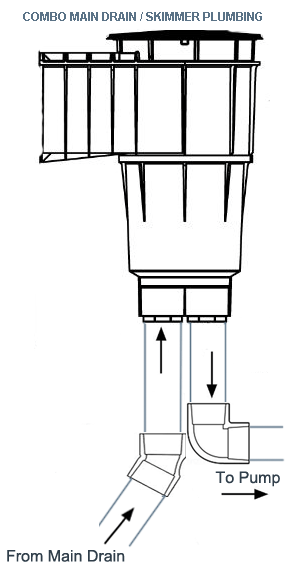
Combination Skimmers, or Combo Skimmers, as I like to call them, have the main drain tied into the front hole of the skimmer, on the pool side, and the back hole, or the deck side hole is connected to the pipe that runs back to the pump.
This type of arrangement requires an additional skimmer accessory to help control the flow coming up from the main drain pipe, and the flow coming "top-down", through the basket - or, the skimmer flow.
Two main types of diverters are used in a combo pool skimmer. Hayward uses a Float Valve, which some pool guys I know like to call a turtle or a spaceship.
There is a flap on the bottom of the float valve that allows you to have some control of how much flow is from the main drain, and how much flow is used for skimming action.

The second type of diverter is just the flap, called a Trimmer Plate, which is screwed onto the bottom of the skimmer. Slide the flap over the main drain pipe to reduce flow from the main drain, 'bottom-up" while increasing the skimming action, or "top-down" flow into the skimmer.
Winterizing this type of Combination skimmer involves blowing air through the main drain hole, and then (very) quickly switching the air hose with a winter plug, tightened up very quickly, before the water rebounds up into the pipe. Then connect the air hose to the rear hole and blow out the pipe to the pump.
Common Inground Pool Skimmer Plumbing
This type of skimmer plumbing arrangement is among the most commonly used. The second hole, usually the hole on the pool side of the skimmer is plugged off with a threaded plug from underneath.
Many times the plug is a few inches below the bottom of the skimmer, and it fills with rocks and debris, making it appear as though it is not plugged. To determine if you have this type of arrangement, stick your fingers (or a screwdriver) down into the hole and see if you can feel the plug.
With this type of single hole use of a pool skimmer, the line that leads to the pump will usually have a valve in front of the pump to control the water flow from this skimmer, and if you have a second skimmer, usually one 3-way valve is used to control both skimmers. In this way, the two skimmer pipes connect underground with a Tee fitting, and then one pipe runs back to the pump.
Because the main drain is not tied into the skimmer in this set-up, pool systems using this configuration usually also have a separate valve to control a separate main drain line that runs from the pool to the pump.
To winterize this common skimmer plumbing style, connect an air hose and your Cyclone blower into the open skimmer pipe (usually the rear hole). Blow air from the skimmer to the pump. If you have more than one skimmer, turn the valves at the pump in such a way to direct air back to the second skimmer. For Jandy-type valves, loosen the handle knob, to pull the handle above the lid-stops, placing the valve backwards, in 'dead-head' fashion. You can also plug the pipe that comes into the pump basket, or place a filter multiport valve into the Closed position.
Old Style Combination Skimmer Plumbing:
Anthony Pools & Sylvan Pools
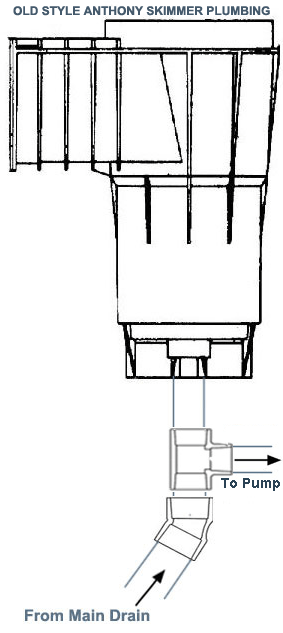
Old Style Anthony Inground Pool Skimmers used a long diverter that screws into a single, center hole, or sometimes they used a two-hole skimmer and plugged the hole on the pool side. With a 1/4 turn of the diverter, you take it from Full Main Drain to Full Skimmer. This design was fairly effective to control the skimmer and main drain flow, as long as the diverter was being used. Winterizing an Anthony skimmer requires two plugs, an extended #8 to plug the drain, and a #10 to plug the skimmer (at the top of the hole). First blow and plug the main drain, then blow out the skimmer line and plug.
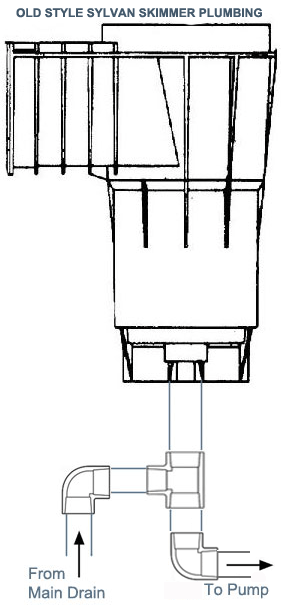
Old Style Sylvan Inground Pool Skimmers used no diverter, and therefore had no control of the flow amounts from the skimmer and the main drain. To vacuum the single hole Sylvan skimmer, one would use a piece of 1" black poly pipe, 12" long. The pipe would hit the bottom of the tee (not shown) and stick up just enough to attach your vacuum hose. Old style Sylvan skimmers were commonly plumbed using black poly pipe, and some of the original sylvan skimmers were made of aluminum. A special double-plug is used for winterizing these skimmers, with limited effectiveness. When the main drain begins to blow strongly, the double plug is slammed-fast into the hole, which seals both drain and skimmer at the same time.
Equalizer Line Plumbing
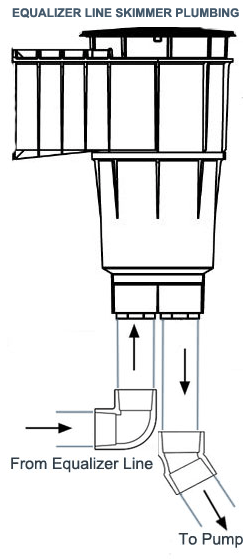
Back in the day, it was common (not so much anymore) to plumb the skimmer with a built-in low water protection, known as an equalizer line. The equalizer line is a suction line installed below the skimmer, about 18" below the tile line.
The purpose of an equalizer line arrangement was to allow the skimmer to keep operating if the pool water level drops below the opening to the skimmer. A spring loaded valve was usually screwed into the front hole of the skimmer, on the pool side. This valve would open up if the skimmer started to suck air.
Not commonly used in public or private pools anymore, this particular pool skimmer configuration is more or less a thing of the past. They can be plugged, if not needed. Or you can open the line and with the use of a diverter, treat it as a LWS, or low water suction line, to help improve circulation, if needed.
If the pool skimmer for your pool needs to be replaced, check out our skimmer selection at In The Swim. We carry many types of wall skimmers for both inground and above ground swimming pools.